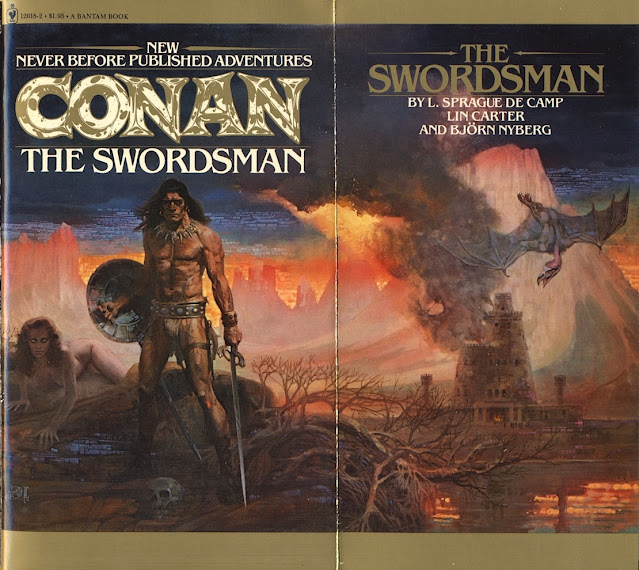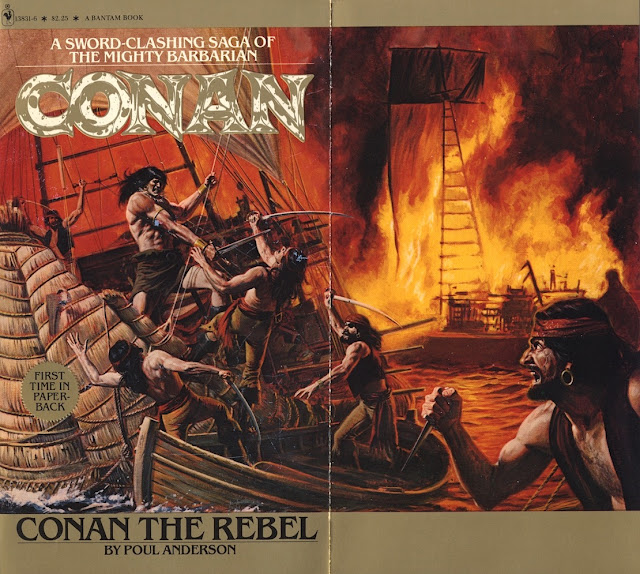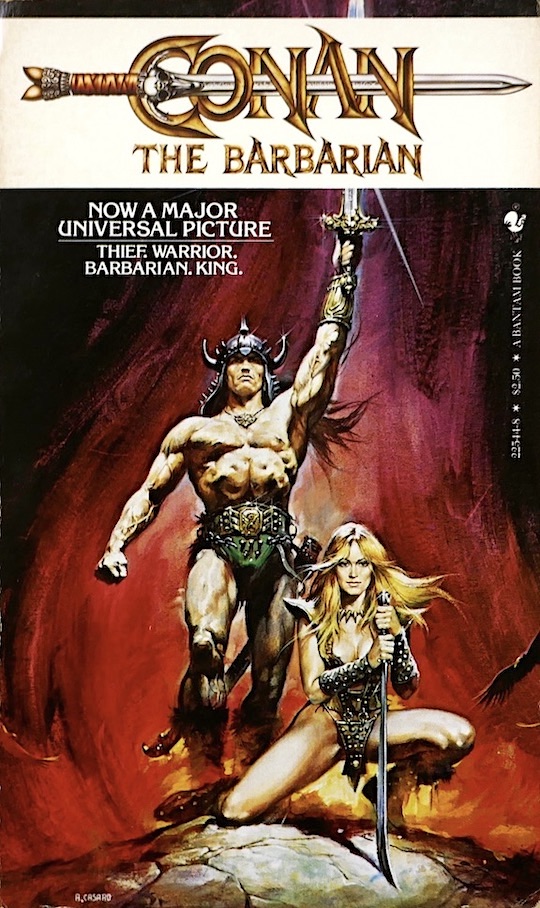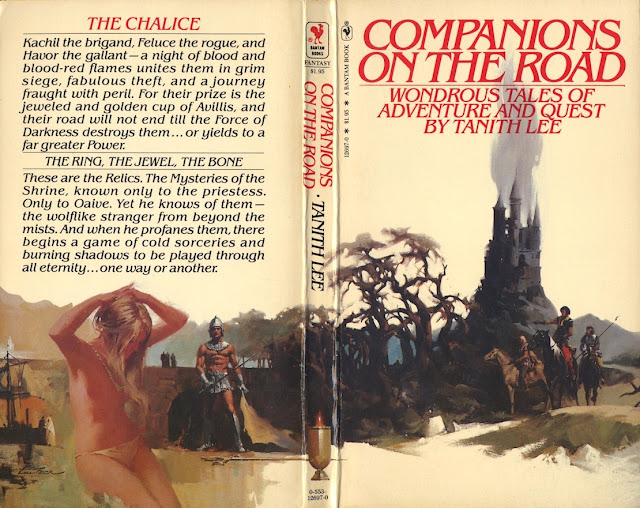BEGINNING in August, 1978, and ending in May, 1982, Bantam Books, under the guidance of their legendary art director Leonard P. Leone Sr., began issuing a series of non-Robert E. Howard material continuing and supplementing the much earlier Lancer/Ace Conan paperback series.
Darrell Greene (credited as Darrel) painted the cover art on volume 1: Conan the Swordsman (Aug, 1978) by L. Sprague de Camp, Lin Carter and Bjorn Nyberg.
Bob Larkin painted the covers for volume's 2 thru 6: Conan the Liberator (Feb, 1979) by L. Sprague de Camp and Lin Carter; Sword of Skelos (May, 1979) by Andrew Offutt; The Road of Kings (Oct, 1979) by Karl Edward Wagner; Conan and the Spider God (Dec, 1980) by L. Sprague de Camp; Conan the Rebel (July, 1980) by Poul Anderson.
Volume 7 happened to be a Conan the Barbarian movie-tie-in (May, 1982), written by L. Sprague de Camp and Lin Carter, with cover art by movie poster specialist Renato Casaro.
Volume 7 happened to be a Conan the Barbarian movie-tie-in (May, 1982), written by L. Sprague de Camp and Lin Carter, with cover art by movie poster specialist Renato Casaro.
ALL SEVEN covers are shown below in ascending order of their sequence. (Note: 1 and 5 have had their images horizontally flipped over; Conan is not, and has never been, left-handed).
 |
| CLICK TO ENLARGE. ART BY DARRELL GREENE |
 |
| CLICK TO ENLARGE. ART BY BOB LARKIN |
 |
| CLICK TO ENLARGE. ART BY BOB LARKIN |
 |
| CLICK TO ENLARGE. ART BY BOB LARKIN |
 |
| ART BY BOB LARKIN |
 |
| CLICK TO ENLARGE. ART BY BOB LARKIN |
 |
| ART BY RENATO CASARO |
BOB LARKIN'S illustrations for the Conan series are some of the best non-Frazetta Conan paperback covers ever produced. They astonished me when I first saw them in Waldenbooks back in 1979 and '80, and I'm no less taken today (Larkin's cover art for the The Savage Sword of Conan magazine published during the 1970's and 80's are astonishing too!).
Larkin was fairly new to the paperback scene in the 1970's but he was already demonstrating a remarkably mature talent (he started illustrating commercially in 1969). Prior to painting the Conan covers, Larkin had completed three excellent paintings for Janet Morris's science-fantasy series Silistra, on volumes 2, 3 and 4, respectively. However, the cover art on volume 1 was painted by Boris Vallejo, so apparently in an effort to unify all of the covers under one sustained look Leone was having Lou Feck, his veteran all purpose artist, redo all four books with new illustrations for their subsequent second printings in 1981 (seen further below).
Shown immediately below are Boris's and Bob's Silistra covers.
Shown immediately below are Boris's and Bob's Silistra covers.
 |
| SILISTRA 1 (1977), ART BY BORIS VALLEJO |
 |
| SILISTRA 2 (1977), ART BY BOB LARKIN |
 |
| SILISTRA 3 (1978), ART BY BOB LARKIN |
 |
| SILISTRA 4 (1979), ART BY BOB LARKIN |
Bantam was also in the midst of reprinting their Conan series that year, starting with Conan the Rebel, Conan the Swordsman, and The Sword of Skelos. Each book was given a brand new cover illustration also by Feck, or at least it sure looked that way upon first glance, which by turn replaced Greene and Larkin's cover art. Why Leone wanted this change is not known, because it seemed to me that even with Greene's inclusion, uniformity had been already been nicely established by Larkin, and Larkin could have easily created a new illustration for Conan the Swordsman to match his others (the same goes for Vol. 1 of Silistra). Nevertheless, Feck was starting to get more sword & sorcery type commissions and to me that was a good thing. However, a closer examination revealed that none of the three Conan's were signed by Feck, and two of them were actually signed as by Zorin.
Now, just who in blazes was Zorin, and why was this person taking credit for what I assumed was Feck's artwork? And, just as important, why had Leone allowed this to happen?
In those days the information highway was pretty narrow in comparison to what it is today, so I had now way of knowing the particulars about decisions made behind closed doors in the publishing industry. I only knew that someone with a possibly fictitious name was now painting in a manner that seemed to emulate an already established industry stalwart. Or maybe not. Maybe it was just Feck painting under a nom de plume for personal reasons.
A few years later I came to realize that Feck was no longer producing cover art at all, ceasing around 1981 or 1982. Not being any wiser, this still being the pre-internet days, I merely assumed that he had retired or moved away from the book-cover business like so many other high profile artists had, i.e., Bob Abbett, James Bama, Dean Ellis, Frank McCarthy and Don Stivers, to name just a few. Then in 1997, through information provided by artist Vincent Di Fate, I came to learn the truth about Feck's disappearance. In November of 1981, Lou Feck had died, the victim of a sudden heart attack. He was just 56 years old. But long before that revelation was sprung, Zorin, the enigmatic artist, had ceased to be even a supposition to me. Then, in the 2000's when I began to earnestly collect paperbacks again based entirely upon their cover art, Feck naturally crept back to the top of my want list.
And not so surprisingly, so did Zorin.
But this time around I wanted to know the truth of their dual existence!
 |
| CONAN THE REBEL (August 1981) |
 |
| CONAN THE SWORDWMAN (August 1981) |
 |
| CONAN THE SWORD OF SKELOS (August 1981) |
To eliminate conjecture, I decide to compare each Zorin Conan cover against several confirmed Feck covers that I already owned, including Feck's earlier masterwork from 1978, Kull The Fabulous Warrior King. Almost immediately I was able to identify components that had been repurposed from other Feck illustrations. Of course I was fully aware that Feck routinely cribbed from his own work to save time and effort, especially when rush jobs and deadlines had to be met. That was the give that Feck gave to his clients when they pushed him to be so ridiculously fast.
It would also seem that the two models who posed for Conan the Rebel and Conan the Swordsman are the very same two that posed for Kull, though that's not necessarily evidence by itself because most New York based illustrators all solicited from the same modeling agencies. Nevertheless, my assessment upon finishing the examination was exactly what I thought it was going to be even before I had begun the process: form, tone, style and brushwork all held to these being the work of Lou Feck.
To me it was no longer an argument.
I'm convinced that Zorin is Lou Feck, but with Len Leone's passing in 2013, how could I ever know with certainty. One option would be to try and contact one of Feck's peers* and ask them if they can provide some clarity on the subject. Thirty-six years later though, the truth of those circumstances is hardly important to anybody outside of those directly involved, but it is fun to surmise.
*ADDENDUM:
Yes, Zorin is Lou Feck! That fact was confirmed to me personally by Bob Larkin and photographer Marc Witz. These men were friends with Feck during those marvelous Bantam years. According to Larkin, Leone was trying to create a name (Zorin) that would be associated with sword & sorcery and heroic fantasy cover art, for reasons only an editor could have. His ruse might've been successful had Feck not been whisked away to the big art studio in the sky.
So, at long last, the "Mystery of Zorin" is officially solved.
Many thanks, Bob and Marc!
NOW let's look at the covers that helped Feck secure the way to Conan:
 |
| CLICK TO ENLARGE |
Kull The Fabulous Warrior King by Robert E. Howard (Bantam, September, 1978).
'On the throne of Valusia sits the dauntless king of barbarian days, Kill, savage outlaw, fierce gladiator, soldier, commander and king of kings who dreamed of golden destiny. Now the dream has become reality, great Kull has slain the despotic King Borna, ripped the crown from his gory head, and mounted his throne as ruler of Valusia, land of dreams, mightiest of the seven empires.'
Cleopatra's Daughter by Andrea Ashton (Bantam, April, 1979).
'From the soldiers who paraded her in golden chains before jeering crowds to the jailer who ravished her to the great Augustus Caesar himself, who gave her coldly in marriage to the foreign prince Juba, she hated them all. For they were Romans. And she was Cleopatra Selene, Queen of fallen Egypt, daughter of Cleopatra and Marc Antony. Yet Rome had made an error when they gave her to Juba. Now she might destroy them as she longed to. And the price? Betrayal! Betrayal of the sun-bronzed hero who thriller her flesh as he filled her soul... of Juba, whose touch she burned for even as she burned for revenge.'
 |
| CLICK TO ENLARGE |
Companions On The Road by Tanith Lee (Bantam, July, 1979).
IF WE regard Feck's Kull the Fabulous Warrior King as the "foundation" upon which he was going to build his reputation for illustrating sword & sorcery, then Cleopatra's Daughter is definitely its "walls." The "roof", I suppose, could belong to Companions on the Road, a historical fix-up novel. These period subjects seemed to bring out the best in Feck's abilities, which certainly didn't go unnoticed by Leone, hence his getting commissions a year later for both William C. Heine's The Swordsman and Janet Morris's Silistra series, and finally the Conan's.
The Swordsman by William C. Heine (Bantam, April, 1980).
Bantam's four Silistra novels by Janet Morris are in ascending order as follows: High Couch Of Silistra (January, 1981); The Golden Sword by (March, 1981): Wind From The Abyss (April, 1981); The Carnelian Throne (July, 1981). Critical reception is varied on this series, but it does have its proponents. I lifted this passage from Wikipedia: 'Charles N. Brown of Locus, is quoted on the Baen Books reissues of the series (cover art by Victoria Poyser) as saying, "Engrossing characters in a marvelous adventure". Frederik Pohl is quoted there as saying "The amazing and erotic adventures of the most beautiful courtesan in tomorrow's universe."
The book has been called "the best single example of prostitution used in fantasy."
Stephen Andrews' 100 Must-Read Fantasy Novels recommends High Couch of Silistra to readers who have enjoyed Jane Gaskell's The Serpent.'
ONE thing I failed to mention before was my complete admiration for Feck's Conan the Rebel illustration. I consider it as one of the very best Conan paperback covers ever produced. Feck's leaner version of Conan was exactly how I pictured him my mind's eye while reading the original Robert E. Howard stories.
Barbarians, including Conan, are generally depicted as brutish and grossly muscled; I've even seen Conan drawn exceedingly stout, like he
was some kind of two-legged rhino with a mullet. But I prefer my barbarians to look and move like lions and tigers and not bears, so here's hoping that the next generation of illustrators will grab the barbarian
by the mane and move him into a more realistic place and build, just
like Renato Casaro, Darrell Greene, Bob Larkin and Lou Feck did lo those many
years ago.
POSTSCRIPT: to learn more about Feck visit my previous article, The Fantastic Paperback Cover Art of Lou Feck (April, 2018).
[Originally posted in Berserker Books in 2014. © Revised July, 2018.]










4 comments:
Thank you for these, I'm pretty certain that Lou Feck also supplied interior illustrations for one of the editions of Frederick Forsyth's 'The Shepherd' after it came out in 1975.
He did indeed. I hope to post a feature about that book in the future. Stay tuned, and thanks for the comment.
Thank you, so much, for this essay! I own an independent bookstore in Utah, and have been cataloging a bunch of Conan mass market paperbacks. I'm also a big sci-fi and fantasy geek with an art history background, so, needless to say, when I create a listing, I like to include all the cool details about who produced amazing cover art or really sweet interior illustrations. I also love the book industry because I feel like I work in a profession in which I'm privileged to learn new things nearly every day. I was puzzled by the Zorin enigma, and don't like to leave any ball of yarn rolled up, so couldn't have been more pleased when I discovered your illuminating writing on the topic. Thanks you!
Your welcome Aaron. Unlike authors who like to use pseudonyms for a variety of reasons, I can't think of any illustrators who actually have (other than Feck), so it was fun discovering the truth about Zorin.
Post a Comment